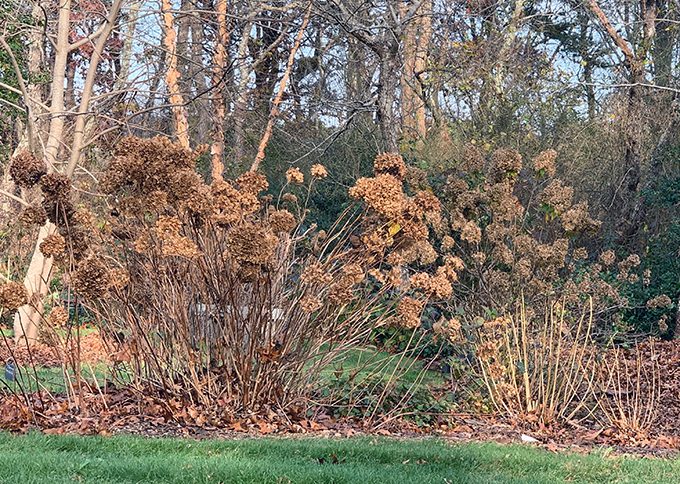Do I Prune My Hydrangeas In The Fall?
Do I Prune My Hydrangeas In The Fall?
Some people notice that their neighbor has trimmed their blue hydrangeas down by half in October. Others wonder if they need to cut the brown flowers off their LimeLight or other Hydrangea paniculatas. Added to these questions is the confusion about when hydrangeas form their flowers, and how to prune them so that the most flowers are produced every summer. Here is what you need to know:
1. Blue Hydrangeas don’t get cut down in the fall. If you do prune them back “to neaten them up” or “make them shorter” you’ll have fewer flowers next year but the plants will be just as tall. Mophead or lacecaps that get cut back will grow a green dome of foliage on the top and only a few flowers around the middle and bottom, as shown in the photo below. So don’t cut these back now, and in the spring the only pruning you’ll want to do is to remove dead tips or canes. Prune in late-May by only removing canes or tops of the stems that have no green leaves at that time.
2. Since Annabelle (one of the Hydrangea arborescens varieties) and LimeLight or other panicle types (Hydrangea paniculata varieties) produce their flowers on new growth you can prune them either in the late fall or early spring. Some people like to prune theirs now so that they remove the old, brown flowers at the same time. You do not have to remove the flowers…they break off and most blow away in the winter anyway. But if you don’t like how they look there is no harm in cutting them off at any point from now until spring.
3. If your mophead or lacecap hydrangea is too tall, plan on moving it elsewhere in April or May. There are many wonderful varieties that stay shorter so plan on replacing the tall one with a shorter cultivar next year.
4. One of the best things you can do for mophead or lacecap hydrangeas now is to rake the leaves that have fallen under and around the plants; this helps keep the population of chilli thrips under control. Chilli thrips are a new pest that disfigures Hydrangea leaves. Read more about it here.
5. To print out our handout about pruning lacecap and mophead hydrangeas, click here.

This photo shows three different types of hydrangeas in the fall. The plant on the left is an Annabelle – a variety of the smooth hydrangea, H. arborescens. The sticks on the right in the foreground are blue mopheads, H. macrophylla. And behind those, in the background, is a ‘Little Lime,’ a H. paniculata. The Annabelle and the Little Lime bloom on new growth so these can get pruned now, in late winter, or in the early spring. The macrophyllas are only pruned by removing dead stems.

This is a Nikko Blue Hydrangea that was cut down “to clean it up” in the fall. The canes were cut to about three feet tall, and as you can see the shrub has grown back to six feet tall and wide by the following July. There are only a few flowers because that “clean up” pruning removed most of the buds. If you prune your blue hydrangeas down in the fall or spring you will have very few flowers. AND, it’s impossible to make them short again.

If you want to cut the brown flowers off your hydrangeas at this time of year it won’t hurt anything, but it does not have to be done. Some people are afraid that “snow and ice will cling onto the flowers and spit or break the branches” but this isn’t really a concern. On the Cape and Islands we usually don’t get heavy snows or ice storms in December while those flowers are still in place. It’s very rare that these shrubs get damaged by snow, ice or cold. We know you should “never say never” but in the 25 years that I have been on Cape Cod I’ve never heard anyone say that their panicle hydrangeas were damaged in the winter. So flower removal, or not, is up to you. (Personally, I’ve never cut them off…they break off in mid-winter and become “Cape Cod Tumble Weeds.”)

If your hydrangea’s leaves looked like this, be sure to clean all the fallen foliage and debris out from under the shrubs. Chilli thrips, which caused this, overwinter in the debris. Removing those leaves and keeping them out of the compost (burn or otherwise destroy) will help control this pest.
Subscribe To Our Newsletter
Sign up for our weekly email about sales and events.
